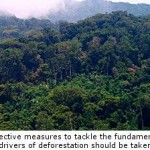
About the Author:
Dr. Mae-Wan Ho is a scientist and co-director & founder of the Institute of Science in Society (ISIS, www.i-sis.org.uk) dedicated to reclaiming science for the public good and to providing critical, reliable and accessible scientific information to the public and policy-makers. She is also one of the editors of the trend-setting quarterly magazine ‘Science in Society’ published by ISIS.
There are plenty of solutions to the current multiple global crisis in finance, climate change and rising food prices that are available and affordable for developing nations and create green growth opportunities, says the latest Trade and Environment Review (TER) [1] released by UNCTAD (United Nations Conference on Trade and Development). UNCTAD is the equivalent of the OECD (Organization for Economic Cooperation and Development) for developing nations.
Much “clean” growth is possible in the developing world with existing technologies, given the right strategy and incentives, TER says.
Instead of belt-tightening in times of financial crisis, as conventional wisdom might dictate, the urgency of the crisis gives governments of the world’s poorest nations the chance to re-direct resources to more efficient economic growth that’s better for the environment, more socially equitable, and more promising over the long term.
TER puts emphasis on three areas of clean growth: energy efficiency, sustainable agriculture, and off-grid renewable power. If done properly, these should yield savings that pay for themselves or even generate quick profits. In addition, shifting to clean growth will create jobs. But to make this happen, governments must eliminate market barriers and policies that prevent the flow of capital into these promising sectors.
“Promoting growth in relevant sectors – including energy efficiency, sustainable agriculture and renewable energies for rural electrification – will not automatically solve the current poverty and climate imperatives. It will, however, provide multiple social, economic and environmental dividends and constitute much-needed first steps towards low-carbon social and economic development,” says Dr. Supachai Panitchpakdi, Secretary-General of UNCTAD.
Buyelwa Sonjica, South Africa’s Minister of Water and Environmental Affairs, adds, “The good news is that it is technologically and financially possible to steer economies in that direction. Indeed, many of the attitudinal and production shifts required are in countries’ best interests, because they can save costs and yield stronger economies.”
Sustainable agriculture is especially important as agricultural production is predicted to decline in the poorest countries in Africa and Asia. As Tim Groser, New Zealand’s Minister of Trade and Associate Minister for Climate Change Issues, says: “We will need to achieve the best possible global production patterns for agriculture that will meet food, development and climate needs. We have an opportunity to achieve win-win-win solutions across the trade, development and climate agendas. Seizing this opportunity requires a long-term view, coherence in the direction and substance of the relevant international frameworks, and a shared commitment from developed and developing countries alike to contribute to global action on climate change.”
Ulrich Hoffmann of UNCTAD Secretariat urges governments to use the crisis as a launch pad for steering the global economy towards a more sustainable growth pattern.
Economic stimulus packages can be used to kick-start clean growth, which are economically self-sustainable once initial investment is made. Innovative policy approaches are needed that generate synergies between creating new jobs (and associated income-generating opportunities), cost reductions resulting from more efficient material/resource and energy use, and lower environmental pressures (including abatement of greenhouse gases).
The findings from UNCTAD’s study corroborate and complement those of ISIS’ reports “Green Energies: 100% Renewable by 2050” [2], and “Food Futures Now: *Organic *Sustainable *Fossil Fuel Free” [3]. In particular, it reinforces the economic feasibility and profitability of going green in a decentralized, distributed manner.
Improving Energy Efficiency Gives Large Savings in Energy Cost
Buildings are the single largest consumer of energy globally, and there is much scope for improving energy efficiency and a huge market potential in both developed and developing countries. According to the much-cited McKinsey Report [4], global market for efficient building technologies is estimated to grow at 6 percent per annum from €87 billion in 2008 to €180 billion by 2020.
The great advantage of such efficiency improvements is that it can be implemented locally, especially within cities as part of Local Agenda 21 (see “Cities and Climate” [5]). Economic returns come quickly in substantial savings on energy. A renovation of the lighting system in the University of Mexico resulted in electricity savings of 59 to 92 percent in different parts of the campus buildings. German legislation has increased building efficiency standards step-wise during the past two decades. Freiburg and other German cities have gone further than required by law. The vision for the next generation of energy efficient buildings is the “plus-energy house”, which produces more energy than it consumes.













